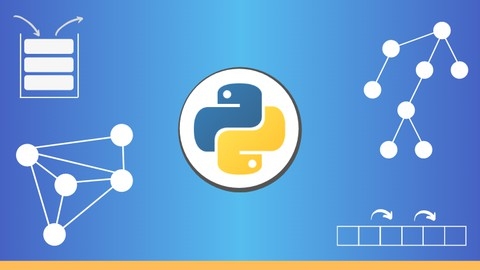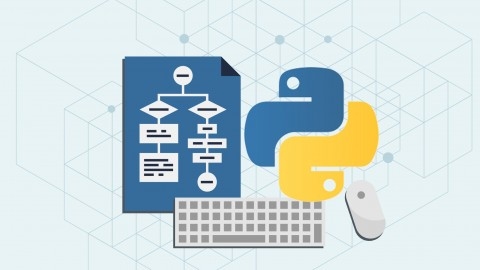Mastering data structures and algorithms (DSA) is crucial for any aspiring programmer.
DSA provides the foundation for writing efficient and scalable code, tackling complex problems, and acing technical interviews.
It’s a game-changer for anyone looking to advance their coding skills.
But finding the right course to learn DSA in Python can be overwhelming.
With so many options available, it’s hard to know where to start.
Many learners struggle to find a course that comprehensively covers all the essential concepts, provides hands-on practice, and prepares them for real-world applications.
For the best overall Python Data Structures and Algorithms course on Udemy, we recommend The Complete Data Structures and Algorithms Course in Python.
This comprehensive course combines theory with practical coding exercises, making it ideal for beginners and experienced programmers alike.
You’ll learn everything from Big O notation and basic data structures to advanced topics like dynamic programming and graph algorithms.
Don’t worry if this isn’t the right fit for you, though.
We’ve researched and compiled a list of other fantastic Python DSA courses on Udemy.
Keep reading to explore our recommendations and discover the perfect course for your learning journey.
The Complete Data Structures and Algorithms Course in Python
Starting with the basics, the course introduces you to the concepts of data structures and algorithms, explaining their importance in programming.
It covers a variety of data structures, including Arrays, Lists, and Tuples, and explores different algorithms, providing a solid foundation for your learning journey.
Python, known for its versatility, serves as the medium for instruction.
Even if you’re new to Python, the course includes a section to bring you up to speed, ensuring no learner is left behind.
A standout feature of this course is its detailed exploration of Big O Notation.
You’ll learn to measure algorithm efficiency, understand space complexity, and tackle input terms, equipping you with critical skills for optimizing code.
As the course progresses, you’ll encounter more complex data structures like Linked Lists (Singly, Doubly, and Circular), Stacks, Queues, Trees, and Graphs.
Practical coding exercises and projects complement the theoretical knowledge, allowing you to apply what you’ve learned in real-world scenarios.
For those aiming to ace tech interviews, the course includes sections dedicated to interview preparation.
You’ll practice with problems from companies like Amazon, Facebook, and Microsoft, preparing you for the challenges of a tech career.
The course also focuses on problem-solving strategies, guiding you through understanding and breaking down problems, and refining solutions.
This approach is crucial for tackling complex programming challenges effectively.
Advanced topics aren’t left out.
You’ll delve into Recursion, Dynamic Programming, Backtracking, and Graph Algorithms, including Dijkstra’s and Bellman Ford’s algorithms.
Topics like Minimum Spanning Trees, Greedy Algorithms, and Divide and Conquer Algorithms are also covered, providing a well-rounded understanding of DSA.
With quizzes, coding exercises, and a supportive student community, this course offers a rich learning experience.
It prepares you not just for interviews but for a successful career in programming.
Python Data Structures & Algorithms + LEETCODE Exercises
This course begins with the basics, such as setting up your code editor, and progresses to advanced topics, ensuring a complete understanding of essential concepts and their application in Python.
The journey starts with an “Overview” to guide you on how to benefit fully from the course.
You’ll quickly move on to Big O notation, learning to evaluate algorithm efficiency through lectures and quizzes on O(n), O(n^2), O(log n), and more.
This foundational knowledge is crucial for writing efficient code.
As you advance, the course covers key data structures, including classes, pointers, linked lists (LL), doubly linked lists (DLL), stacks, queues, trees, hash tables, graphs, and heaps.
Each section offers detailed explanations and Python implementations, complemented by coding exercises that reinforce your learning.
Sorting algorithms aren’t left out.
You’ll gain hands-on experience with bubble sort, selection sort, insertion sort, merge sort, and quick sort, understanding not just how to implement them but also their performance implications.
A standout feature of this course is its focus on interview and LEETCODE exercises.
After mastering each data structure or algorithm, you’ll tackle challenges that mirror real interview questions, from linked list manipulations to dynamic programming problems like memoization in the Fibonacci sequence.
The course also explores tree traversal (BFS and DFS), dynamic programming, and strategies for solving overlapping subproblems.
This approach ensures you’re equipped not just with coding skills but also with problem-solving strategies.
Wrapping up with a “Thank You!” note, the course emphasizes continuous practice.
You’re encouraged to revisit sections and exercises to solidify your understanding and skills.
Data Structures Algorithm DSA | Python+Javascript LEETCODE
This comprehensive course starts with the fundamentals, introducing you to data structures and algorithm complexity, including Big O notation.
You’ll quickly move on to tackle arrays, learning essential operations and solving problems like creating a sorted squared array and identifying monotonic arrays.
As the course progresses, you’ll explore more complex data structures such as hash tables, linked lists (singly and doubly), and stacks and queues.
Each section includes coding interview questions from leading tech companies, offering you practical experience.
For example, you’ll get to design a stack using a linked list and implement a queue with a stack, gaining hands-on skills that are directly applicable to real-world scenarios.
You’ll also master sorting algorithms like merge sort, quick sort, and radix sort, understanding both their implementation and the logic behind their efficiency.
Recursion is another key topic, with exercises on the Fibonacci sequence and power sum calculations to solidify your understanding.
Graphs are covered in depth, with lessons on breadth-first search (BFS) and depth-first search (DFS), taught both recursively and iteratively.
You’ll solve complex problems such as determining the number of components in a graph and using topological sort for course scheduling.
What sets this course apart is its practical approach.
After each lecture, you’re challenged with quizzes and coding exercises in both Python and JavaScript, allowing you to apply what you’ve learned right away.
Solutions are thoroughly explained, including Big O analysis, to give you a deep understanding of why certain solutions work best.
Additionally, the course includes a lecture on study techniques to help you focus and study more effectively, preparing you not just technically but also mentally for coding interviews and professional challenges.
Data Structures and Algorithms In Python ( DSA )
This comprehensive program takes you from basic concepts to advanced techniques, all through the lens of Python, a language celebrated for its clarity and efficiency.
The course kicks off with an introduction to Data Structures and Algorithms, setting a solid foundation.
You’ll quickly move on to essential topics like measuring algorithms’ running time, Asymptotic Analysis, and Big O Notation.
These sections are critical for understanding how to optimize your code’s performance.
Quizzes such as Introduction Quiz A and B are interspersed throughout, allowing you to check your understanding before advancing.
The curriculum then guides you through various data structures, starting with Linked Lists.
You’ll master operations ranging from simple traversals to complex sorting and reversing techniques.
The course also covers doubly linked lists, circular linked lists, and the nuances of linked lists with header nodes.
In the Stacks and Queues section, you’ll learn their implementations, both in arrays and linked lists, and explore special types like circular queues and priority queues.
Practical applications, such as evaluating arithmetic expressions, demonstrate these structures’ real-world utility.
Sorting and searching algorithms are thoroughly covered, with detailed instructions on implementing Selection Sort, Bubble Sort, Insertion Sort, Merge Sort, Quick Sort, Shell Sort, and Radix Sort in Python.
Each algorithm’s efficiency is analyzed to give you a clear understanding of its performance.
The course also demystifies complex structures like Binary Trees, Binary Search Trees, and Heaps.
You’ll learn about their types, traversals, and operations, supported by quizzes to test your knowledge.
Hashing, a key technique for efficient dictionaries, is explained in depth.
You’ll explore hash functions, collision handling, open addressing, and separate chaining, learning how to implement these concepts in Python.
A bonus lecture offers recommendations and special offers on other courses, encouraging continuous learning.
Data Structures and Algorithms Python: The Complete Bootcamp
The course starts with an introduction, setting you up for success by walking you through the curriculum and pointing you to the Github repository for code resources.
Early on, you’ll tackle Big O Notation, learning to analyze algorithm efficiency and understand space complexity, which is crucial for optimizing your code.
As you progress, essential concepts like memory and logarithms prepare you for diving into various data structures.
You’ll explore arrays, linked lists, stacks, queues, hash tables, trees (including binary and AVL trees), heaps, tries, and graphs.
Each section covers introductions, operations, and the performance of these structures, ensuring you grasp both theory and application.
The course also covers a wide range of algorithms, starting with basic searching techniques like linear and binary search.
Sorting algorithms are thoroughly explored, from bubble, selection, and insertion sorts to more advanced methods like quicksort and merge sort, teaching you efficient data organization.
Additionally, you’ll master tree and graph traversal techniques, including depth-first and breadth-first searches, essential for working with complex data structures.
What sets this course apart is its focus on real-world application.
Through coding challenges, you’ll apply what you’ve learned, tackling problems such as creating a min stack, designing and reversing a linked list, constructing binary trees, and more.
These practical exercises are designed to prepare you for technical interviews and everyday programming tasks.
Advanced Data Structures and Algorithms in Python ( DSA )
The course starts with a thorough introduction to advanced DSA, guiding you through setting up a source code repository, a critical step for tracking your progress and managing code changes effectively.
The course covers essential topics such as AVL Trees, where you’ll learn about rotations, insertions, and deletions through practical examples.
It also dives into Threaded Binary Trees, Expression Trees, and B Trees, teaching you operations like insertion and deletion, crucial for optimizing data storage and retrieval.
Graph theory is another key focus, with lessons on graph terminology, cycles, and connectivity.
You’ll master representing graphs using adjacency matrices and lists in Python, a skill vital for solving complex coding problems.
The course also explores graph traversal techniques, including Breadth First Search (BFS) and Depth First Search (DFS), and their Python implementations, equipping you with strategies for exploring and searching graphs efficiently.
Additionally, you’ll tackle the Shortest Path Problem with Dijkstra’s Algorithm and learn about the Minimum Spanning Tree of a graph through Prim’s and Kruskal’s algorithms.
These sections are pivotal for understanding network routing and creating efficient networks.
Concluding with a bonus lecture that offers further learning opportunities, this course ensures you’re well-prepared to handle advanced data structures and algorithms in Python.
Data Structures & Algorithms using Python - Ultimate Course
Starting with recursion, you’ll learn how functions can call themselves to simplify complex problems into manageable tasks.
This foundational knowledge paves the way for exploring essential data structures like arrays, linked lists, stacks, queues, and deques, with dedicated lectures on both theory and practical coding.
Quizzes throughout the course test your understanding, ensuring you’re ready to move on to more advanced topics.
Sorting algorithms, including bubble sort, selection sort, insertion sort, quick sort, and merge sort, are covered in depth.
You’ll not only learn how to implement these algorithms in Python but also when and why to use them, thanks to focused lectures on their theory, coding, and complexities.
The course also demystifies searching algorithms, offering detailed instructions on linear search, binary search, interpolation search, and jump search.
Through hands-on coding exercises, you’ll master techniques to efficiently locate elements within datasets.
This course stands out by blending theory with extensive coding practice, allowing you to apply DSA concepts in real-world scenarios.
Python for Data Structures, Algorithms, and Interviews!
The course starts with setting up your learning environment, guiding you through the course structure, and showing you how to access help and FAQs.
You’ll learn to identify the right company and job types for your career, craft a compelling resume using the best online tools, and establish a strong online presence with professional LinkedIn and GitHub profiles, plus your personal website.
The course emphasizes the importance of networking, offering strategies to expand your connections and leverage them for job opportunities.
Organizational tips for your job search are provided, including a curated list of job boards and company matching sites.
The interview preparation section is comprehensive, covering both technical and non-technical aspects, salary negotiation, and reference preparation.
On the technical front, the course dives deep into Python programming, from basics to advanced topics like Big O notation, array sequences, and graph algorithms.
Each module includes practical examples and interview problems to solve, ensuring you’re well-prepared for technical interviews.
Mock interviews with companies like an E-Commerce Company, a Large Search Engine Company, a Ride Share Start-Up, and a Social Network Company give you a taste of real-world interview scenarios.
Algorithms and Data Structures in Python (INTERVIEW Q&A)
It kicks off with the essentials of complexity theory, teaching you to optimize algorithm performance, a skill critical for both interviews and efficient coding.
The course guides you through setting up Python and PyCharm, ensuring you have the tools needed for effective programming.
It dives into data structures, starting with the basics and moving on to arrays, linked lists, stacks, and queues, complete with quizzes and exercises like reversing arrays and solving palindrome problems to solidify your understanding.
You’ll explore complex data structures such as binary search trees, AVL trees, and red-black trees, learning their operations and implementations.
The course also covers heaps and associative arrays, emphasizing their practical applications.
Graph algorithms are thoroughly examined, from traversal techniques like breadth-first and depth-first search to shortest path algorithms like Dijkstra’s and Bellman-Ford, and spanning tree algorithms like Kruskal’s and Prim’s.
Real-world applications, including WebCrawlers and the critical path method, illustrate these algorithms’ practical uses.
Substring search algorithms and sorting algorithms are also detailed, teaching you efficient search techniques and sorting methods from basic to advanced, including quicksort, merge sort, and non-comparison-based sorts like counting sort and radix sort.
The course concludes with a section on other algorithmic problems and a crash course in complexity theory, preparing you for interviews with practical exercises and downloadable materials for review and practice.









